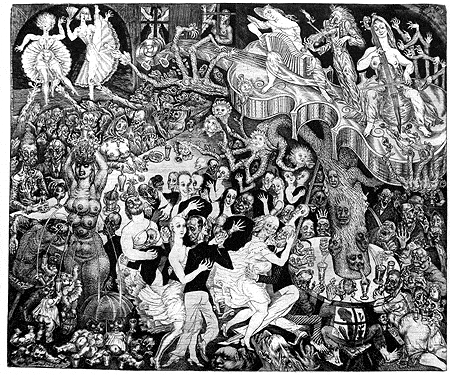In 1939 Christopher Isherwood wrote Goodbye to Berlin which later became the basis for John van Bruten‰s play, Fred Edd John Kander‰s musical and finally Bob Fosse‰s famous film Cabaret (1972) with Liza Minelli in the leading role. In 1931 in Strasbourg, the Estonian graphic artist Eduard Wiiralt engraved his Cabaret (etching, copperplate) which depicts and expresses the same theme Europe‰s wanton lust for pleasure, and the role imposed on an artist in that frenzied show, under the cover of which dictators were seizing power and a new war was brewing. If the film comprised all those elements, Wiiralt has portrayed the symbols of war and power and the false prophets bewitching the masses, in the Cabaret‰s twin work called Hell (193032, etching, copperplate) and in the lithograph The Preacher (1932). In order to convince, a film has to be true to its milieu, and to a particular epoch. In that sense, Wiiralt had more freedom: reflecting the social problems of his time, he created a general critical picture of man tackling militancy and the lust for power, in the context of vicious passions and destructive sexuality, so typical of man. The message of these three works of art again emerges in the artist‰s later work: in 193637 when the Spanish Civil War Ö a rehearsal for the Second World War Ö broke out, and in 194850, i.e. the years of the Cold War.
The three above-mentioned works constitute a summary of the range of ideas in the artist‰s earlier work, a culmination of its stylistic development, and the highpoint of his whole output. Eduard Wiiralt (18981954), the founder of the Estonian estamp tradition, one of the most masterly and variegated engravers, studied between 1919 and 1924 at the ëPallas‰ Art School in Tartu, between 1922 and 1923 at the Dresden Academy of Fine Arts, and lived from 1925 until 1939 and 194654 in Paris that can be regarded his second, artistic homeland. Only when World War II broke out in autumn 1939, did he return to Estonia. There he lived through difficult years of occupation and war. Via Vienna, across the incessantly bombarded and shattered Germany he reached Sweden from where he finally travelled back to his beloved Paris. He has now found his final resting place in the Père-Lachaise cemetery.
Wiiralt reacted with alacrity to the artistic trends of the period: in the ‰20s to Expressionism, Verism, Art Déco, Surrealism; in the ‰30s to the general tendency of classicism. But his style retained its originality throughout, expressing similarly original attitude towards life. The extraordinarily lively and dynamic style of Cabaret and Hell inspired the film producer Rein Raamat to bring Hell to life (1983) in a film where the characters of the original work are animated. Its profounder aim is, naturally, to stress the ever-topical message contained in these two works, and also in The Preacher.
On 20 March we celebrate Eduard Wiiralt‰s 100th anniversary. The Art Museum of Estonia will open a large-scale exhibition of the artist‰s works. One of the places of honour has been given to his etching Cabaret, originally titled The Dance of Life by the artist.

